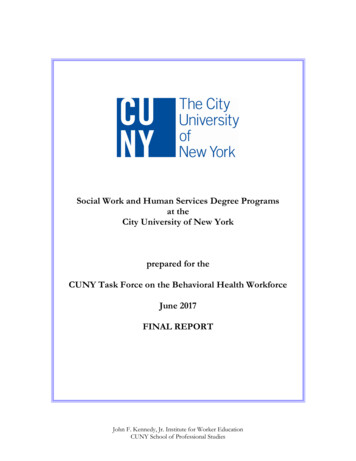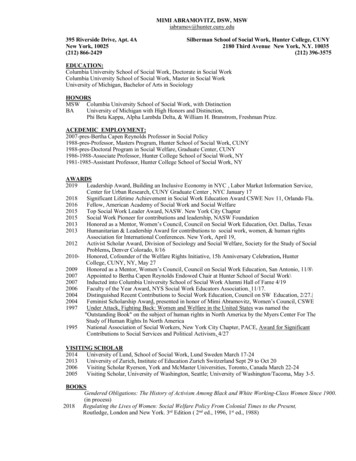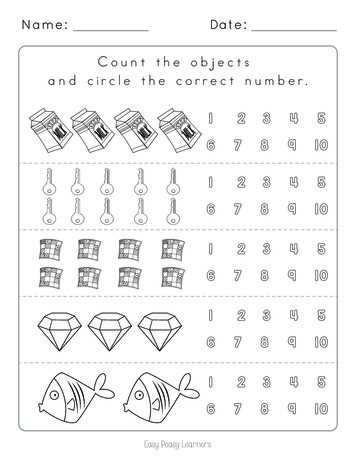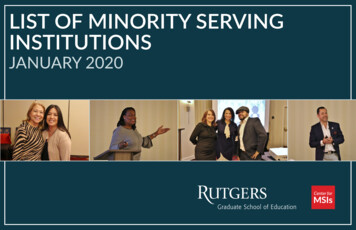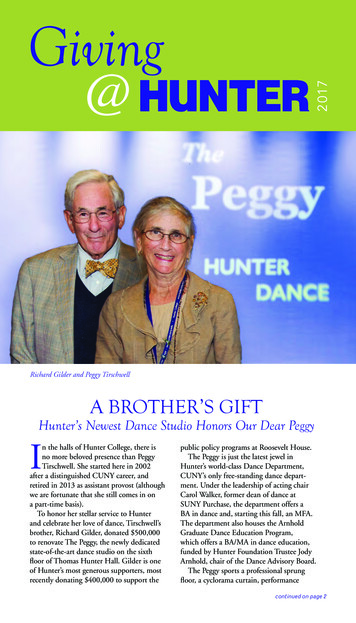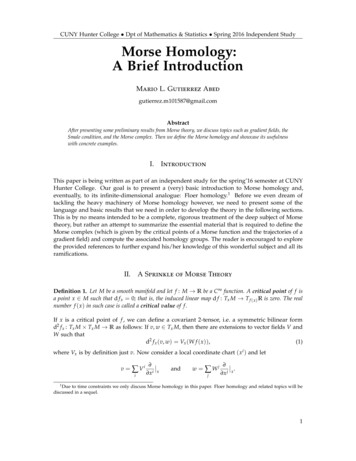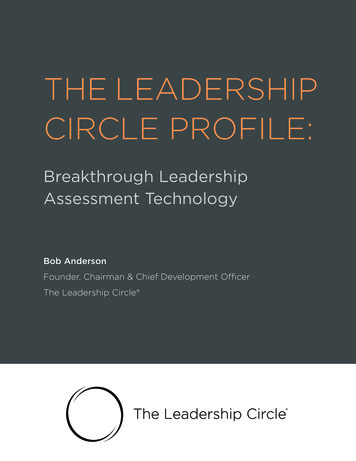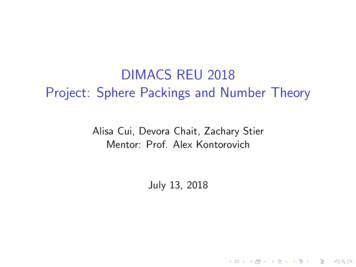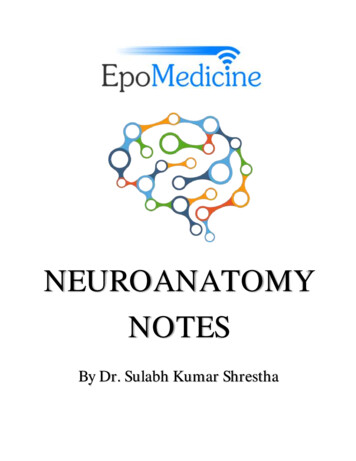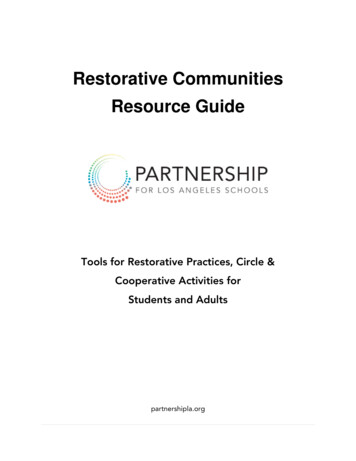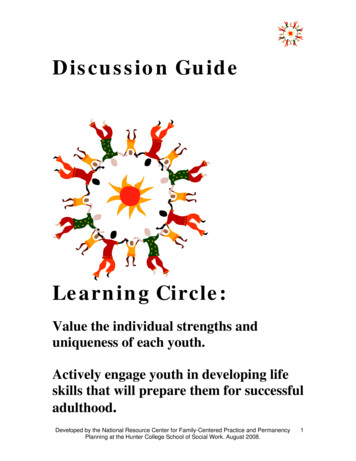
Transcription
Discussion GuideLearning Circle:Value the individual strengths anduniqueness of each youth.Actively engage youth in developing lifeskills that will prepare them for successfuladulthood.Developed by the National Resource Center for Family-Centered Practice and PermanencyPlanning at the Hunter College School of Social Work. August 2008.1
Preparation for Adulthood: Supervising forSuccessDiscussion GuideLearning Circle: Value the individual strengths and uniquenessof each youth. Actively engage youth in developing life skillsthat will prepare them for successful adulthood.Activity One:Focus QuestionsObjectives: To facilitate a discussion of strengths-based practice andpreparation work among members of the learning circle community.Time:45 minutesMaterials:Flipchart paperMarkersTalking Balls/SticksFocus QuestionsRe-numbering Exercise: Participant PacketFacilitator Notes:Welcome the participants back to the learning circle and provide an overview ofthe day’s topic. State that we are going to spend the day talking about strengthsbased practice and how to integrate this approach into life skills preparation.Ask group members to report back on activities or materials that they’ve usedsince the last learning circle. The facilitator can ask for volunteers or can just goaround the circle to give all participants the opportunity to share.Divide participants into smaller talking circles and give each group their owntalking ball/stick. Inform the group that when a participant is in possession of thisobject, the focus is on him/her and what he/she is saying. All others should listendeeply to what this person has to say. The goal of the discussion in the smallgroups is to ensure that participants really spend time talking in depth about theidentified focus questions.Note to Facilitator: The following strategies can also be used to facilitate thefocus questions; The World Café and Technologies of Participation.Developed by the National Resource Center for Family-Centered Practice and PermanencyPlanning at the Hunter College School of Social Work. August 2008.2
Facilitator introduces the focus questions identified below:Present the first focus question for the learning circle and write it out on the flipchart. Inform participants that the second focus question will be addressed afterlunch. In your supervision, how do you encourage staff to focus on astrengths-based perspective? What tools or strategies to you use? What should a “prepared young person” look like when they leavefoster care? What are the challenges in supervising staff that areresponsible for helping young people acquire life skills?During the discussion, facilitator should circulate throughout the room to ensurethat groups are focused on the task and using the talking balls/sticksappropriately. Once groups have discussed the focus questions, facilitatordebriefs the small group conversations with the following probing questions: In response to the first question, what were some of the toolsdiscussed?What are some of the issues that surfaced in your discussionspecific to helping young people acquire the necessary life skills forthe transition from foster care?Facilitator reconvenes large group and asks group members to share thehighlights from their conversations around each of the focus questions.Facilitator records responses on the flip chart.Refer participants to the Handout: Re-Numbering Exercise in their participantpacket and tell the group to use whatever learning methods work best for them tolearn the new numbers.Give them one minute to learn the new numbers. Then, tell them to turn overtheir handout, take out a piece of paper and recall as many numbers as possible.When finished, have everyone turn over their handout and review their work.Ask for a show of hands to indicate how many they had right; starting with all tenand working down. Ask the participants that have the most correct answers howthey learned the new numbering symbols.Ask the group if anyone believes that we all could have gotten 100% if theinformation had been presented differently. On the flipchart, show the group theimage below, which resembles the key pad of your cell phone. If we askDeveloped by the National Resource Center for Family-Centered Practice and PermanencyPlanning at the Hunter College School of Social Work. August 2008.3
someone to learn new information and give them something they already knowas a reference point, it makes learning new information easier.Therefore, today we are going to build on your existing knowledge of strengthsbased practice and integrate a series of tools and techniques which will alsoensure effective preparation for adulthood work with young people.Now, we are going to look at a series of digital stories representing the views ofsupervisors, workers and young people.Developed by the National Resource Center for Family-Centered Practice and PermanencyPlanning at the Hunter College School of Social Work. August 2008.4
Activity Two:Voices from the FieldObjectives: To appreciate the multiple perspectives on issues related tostrengths-based practice and preparation for adulthood.Time:45 minutesMaterials:Digital Stories (Supervisors - Erin; Workers – Aurora, ErinGladstone, Diane; Youth – Jennifer, Jessica, and Josh).Facilitator Notes:Introduce the concept of digital media stories and talk with group about thepurpose of the stories, how they’re made and where they can obtain a free copyof the DVD’s After viewing the stories, ask group members to discuss what they’ve seen in thecontext of their earlier conversations around strengths based practice andpreparation for adulthood. Use the following questions to facilitate discussion: What are some of your reactions to the stories?How did the different roles illustrated by the stories represent a strengthsbased philosophy?After viewing the stories, what would be preparation for adulthood worklook like in an ideal world?Facilitator transitions into a discussion of the various tools and techniquesavailable to supervisors and workers.Developed by the National Resource Center for Family-Centered Practice and PermanencyPlanning at the Hunter College School of Social Work. August 2008.5
Activity Three: Tools and Techniques – Valuing Strengths andPromoting Preparation for AdulthoodObjectives: To explain a strengths-based framework for practice.To describe three strengths-based assessment tools.To explain how life skills assessment can be integrated intoplanning with young people.To describe a life skill assessment process.To interpret the ACLSA Score Report.Time:3.5 hoursMaterials:Handout: Case #1Handout: Case #2Handout: Comparing the Two Perspectives: Determining theDifferences.Participant Resource PacketCharting My CourseHandouts: Life Skills Strengths/Needs Assessment,Beginnings: Getting to Know You,Individual Life Skills Progress Form (on project websitewww.hunter.cuny.edu/socwork/nrcfcpp/pass under learningcircle/session materials)Internet access to demonstrate the resources available at theCasey Life Skills website www.caseylifeskills.orgSample ACLSA Score ReportActivity Source:Strengths-Based Assessment Strategies with Youth,Children FIRST, Fordham University, 2003Competency-Based Assessment System for Life Skillsdeveloped by Joan Morse and Dorothy Ansell for NewJersey Department of Human Services, Division of Youthand Family Services, 2005 and now part of Ansell-CaseyLife Skills Assessment Plus developed by Casey FamilyPrograms and NRCYS, 2006Facilitator Notes:Lecture: Strengths-Based PracticeState that a strengths-based approach looks at skills, competencies, talents, goals,past successes, attributes, interests and wants – AS WELL AS the problems, needs,and challenges.Developed by the National Resource Center for Family-Centered Practice and PermanencyPlanning at the Hunter College School of Social Work. August 2008.6
State that Dennis Saleebey, editor of The Strengths Perspective in Social WorkPractice, outlines the following way to focus on strengths. He calls it “CPR.”Draw a triangle on the flip chart. By the lower left part of the triangle place a “C”which stands for capacity, courage and creativity. Facilitator asks, “What toolsare we using to assess the C’s and what does practice look like when youembrace the 3 C’s?” On the top of the triangle place a “P” which stands forpotential, purpose, and possibilities. On the lower right part of the triangle, placean “R” to represent reserve, resilience and relationships.State that when working with youth, we need to be focused on “CPR”and form a relationship which has acceptance and acknowledgement at thecornerstone. State that we have become accustomed to using to assessment toolsto get at what is wrong with youth. Saleebey’s model provides with an alternativeparadigm for thinking about what is right with the young people with whom we work.When we talk about strengths based assessment, we need to change the labelsand consider all of the components of the CPR model. Strengths-basedassessment exists in the context of relationships and these relationships need tobe accepting and acknowledging. In Saleebey’s opinion, we need to be able to“administer” CPR to our youth and help young people with developing reserves.Facilitator transitions conversation into a discussion about strengths basedassessments. Ask the group the following question: When we are conductingassessments, what is the lens through which we assess the youth with whom wework?State that strengths-based assessment serves as the foundation for decidingwhat, if anything, needs to change and how a worker and youth affect thatchange.State that strengths are an integral part of any assessment. Strengths-based practicefocuses on the youth’s strengths as opposed to problems. Strengths focus onwhat a person can do, what he or she likes to do, and the people who arewilling to help him/her attain goals. State that in your supervision with staff, it iscritical to work with staff to strike the balance between the trauma experiencedby their youth, their areas of need with their strengths and the components ofSaleebey’s model.Refer participants to their resource materials Strengths Can Be. This handoutprovides a broad overview of the areas in which strengths can be explored withyouth. These areas include: skills, talents, personal virtues and traits,interpersonal skills, cultural knowledge and lore, family stories and narratives,knowledge gained from struggling against adversity, spirituality and faith, andhopes and dreams. Encourage group members to think about how youth mightDeveloped by the National Resource Center for Family-Centered Practice and PermanencyPlanning at the Hunter College School of Social Work. August 2008.7
respond to questions about these components of strength and what kinds ofquestions might elicit this information.Presentation of Tools and Techniques:Case Study – Skill Building ActivityState that we are now going to analyze an actual case situation. Divideparticipants into groups of 4 or 5. Distribute Handout: Case #1. Ask participantsto read the case and answer the following questions on the Handout: Comparingthe Two Perspectives: Determining the Differences. Ask participants to respondbased solely on the information presented not what someone SHOULD do.Advise them to be detailed with responses. Give them fifteen minutes tocomplete the activity. How would this view of Emmanuel influence a treatment/service plan?How would this view of Emmanuel guide the attitudes of professionalsworking with him?How would this view include his cultural identity?How would this view determine the way the family is involved intreatment?How would this view influence the development of a post release/aftercareplan?Distribute Handout: Case #2. Ask participants to answer the same questions.Note to Facilitator: Case Background Information: This is an actual case butthe state has been changed. The first case study represents information receivedby a worker asking her to provide intervention. She was asked to use astrengths-based assessment since the first one provided very little information.Refer participants to their resource materials Strengths-Based Assessment forYouth as a tool to reveal the information in Case #2. This provides a powerfulillustration of how strengths-based approaches influence practice andintervention.Discuss with participants how the words we write dramatically impact theapproach we take with our young people and our view of them. Discuss thepower of strength-based assessment and the change in the way in which allmembers of the family are now viewed. Facilitator should point out that this is apowerful activity to use with staff in unit meetings.Refer participants to the resource material Strengths-Based Assessment forYouth and ask the group to comment on the types of questions that were used.Developed by the National Resource Center for Family-Centered Practice and PermanencyPlanning at the Hunter College School of Social Work. August 2008.8
Discuss with participants that we have looked at strength-based assessment atgreat length and each participant has a list of strength-based questions that theycan integrate into their assessments. Reiterate that the idea of strength-basedpractice is that there is a balance achieved in our discussions with youth abouttheir needs and problems, as well as their strengths, assets and wants. The keyto strengths based practice is BALANCE. The goal of strengths based practice isto raise the motivation of youth to participate fully in their case planning anddecision making about their lives. If we only point out their faults and theirproblems, we give them little hope that they will be able to achieve their dreams.Charting My Course – Skill Building ActivityAsk the group if they are familiar with Person-Centered Planning. Provide thefollowing definition:Person-centered planning is a process-oriented approach to empoweringpeople with disability labels. It focuses on the people and their needs byputting them in charge of defining the direction for their lives, not on thesystems that may or may not be available to serve them. This ultimatelyleads to greater inclusion as valued members of both community andsociety.Person-centered planning involves the development of a "toolbox" ofmethods and resources that enable people with disability labels to choosetheir own pathways to success; the planners simply help them to figure outwhere they want to go and how best to get there.(Source: www.ilr.cornell.edu/edi/pcp/)Distribute Charting My Course and state that this type of assessment uses aseries of maps to do with the young person or it can be incorporated intoteam meetings where those invited by the young person give input. This toolwas adapted from various person-centered planning tools. If this tool is usedin meetings, it is important that the young person drives the discussion.Nothing should go on any of the maps if the young person is not inagreement.Review the seven maps with the group. Use the following information whenpresenting the maps:MAP One:What are your life’s dreams?This question sets the tone for developing the plan. It is important to listento your partner and try to get to the real dream and be totally nonjudgmental. As the guide, it is important to watch that your bodylanguage does not negatively impact the process. It is important to notDeveloped by the National Resource Center for Family-Centered Practice and PermanencyPlanning at the Hunter College School of Social Work. August 2008.9
“kill” a young person’s dreams even if you feel that the dream is notrealistic.MAP Two: What are your nightmares? What are you most afraid of?This is the most difficult question. The nightmare and the dream are ofequal importance. In order to achieve the dream, we must avoid thenightmares. The nightmare allows people the dignity to let their monstersand demons out of the closet in an atmosphere where they are heard,recorded, respected, and planned for avoiding.MAP Three: What are my strengths and talents?This map focuses on the concept of “gifts,” not as an academic ability, butas a totally well-rounded person. It is important for each member to statehis/her strengths and talents using positive language.MAP Four: What are my likes and dislikes?This map gets the focus person start to examine the things that they likeand dislike.MAP Five: Who do I go to?We have included these questions to help the focus person begin to seethe types of support that different people provide. It prepares them for thenext map, Circles of Support.MAP Six: Circles of SupportThis allows the focus person to visually see their circles of support. Thefocus person writes their name in the middle circle and then places thepeople who offer them the most support closest to them, eventuallymoving towards the outer circles. It is important to help the focus personidentify supportive people and/or groups and organizations.This is similar to My Social World that we discussed in the permanencylearning circle.MAP Seven: Plan of ActionThis map creates the plan of action. In order to prevent the nightmarefrom happening and to facilitate the dreams becoming true, the focusperson and/or group are asked to, in a very specific way, identify theDeveloped by the National Resource Center for Family-Centered Practice and PermanencyPlanning at the Hunter College School of Social Work. August 2008.10
plans. The plans should include who will do what, and when will they do it.State that strengths-based assessment is a process to get to a product – it isabout helping the young person to identify their dreams and goals and thenhelping them to develop a plan to achieve their goals.Facilitator divides group into pairs and asks them to interview each other usingthe Charting My Course materials. Facilitator debriefs the activity and asksparticipants to reflect on their experience with completing the interview andprocess for themselves.Facilitator asks participants how they would use this type of tool in theirsupervision.The Asset Checklist – Skill Building ActivityReview the materials on The Developmental Assets framework created by theSearch Institute that was discussed in the learning circle on youth development.State that the developmental assets are positive “building blocks” (relationships,experiences, values, attitudes and attributes) that all children and youth need tosucceed. The developmental approach refers to how the building blocks bothemerge from and help shape the ways in which children and youth grow anddevelop. Assets focus on positive building blocks that give strength to childrenand youth.State that the Developmental Assets are not a program but a framework forlooking at how programs support children and youth. The assets can be used asa lens through which to view your work with children and youth. Thedevelopmental assets are another tool for accomplishing the goals of any schoolbased program.There are two types of assets. The external asset category focuses on externalstructures, relationships and activities that create a positive environment foryoung people. The four external asset categories are: Support,Empowerment,Boundaries and Expectations, andConstructive Use of Time.The internal asset category reflect internal values, skills and beliefs that youngpeople also need to fully engage with and function in the world around them. Thefour internal asset categories are: Commitment to Learning,Developed by the National Resource Center for Family-Centered Practice and PermanencyPlanning at the Hunter College School of Social Work. August 2008.11
Positive Values,Social Competencies, andPositive Identity.Note to Facilitator: The following information was obtained from the Search Institutewebsite ( www.search-institute.org) and can be incorporated into your discussion of theframework.Researchers have learned a great deal in the past several decades aboutelements in human experience that have long-term, positive consequences foryoung people. Factors such as family dynamics, support from community adults,school effectiveness, peer influence, values development, and social skills haveall been identified as contributing to healthy development. However, thesedifferent areas of study are typically disconnected from each other.The framework of Developmental Assets steps back to look at the whole in aneffort to pull many pieces together into a comprehensive vision of what youngpeople need to thrive. In addition to roots in the scientific research on adolescentdevelopment, the assets grow out of two types of applied research:Prevention, which focuses on protective factors that inhibithigh-risk behaviors such as substance abuse, violence,sexual intercourse, and dropping out of school.Resiliency, which identifies factors that increase young people's ability torebound in the face of adversity, from poverty to drug-abusing parents todangerous neighborhoods.The Developmental Assets framework and terminology was first introduced in1990 through a Search Institute report titled “The Troubled Journey: A Portrait of6th-12th Grade Youth,” which was sponsored by Lutheran Brotherhood throughits RespecTeen Program. At that time, the survey identified and measured 30Developmental Assets.We continued to review the research, as well as conduct our own studies,cumulatively surveying more than 350,000 6th-12th graders in more than 600communities between 1990 and 1995 to learn about the Developmental Assetsthey experienced, the risks they took, the deficits they had to overcome, and theways they thrived.We also conducted numerous informal discussions and focus groups, in particular tobetter understand the developmental realities of youth of color and youth indistressed communities. Those focus groups led us to elaborate more on safety andcultural competence as assets in adolescence. As a result of all those ongoingDeveloped by the National Resource Center for Family-Centered Practice and PermanencyPlanning at the Hunter College School of Social Work. August 2008.12
research activities, in 1996 we revised the Developmental Assets framework into itscurrent form, a model of 40 Developmental Assets.Facilitator asks participants to reference resource material, An Asset Checklistwhich was developed by the Search Institute. The checklist is based on 20internal and 20 external assets.Ask participants to share what was important to them. Discuss that all of us havea number of these assets. We are not expected to have all of these assets, butwe know that the more assets we have, the easier time we have with navigatinglife’s difficulties.State that our goal is to ensure the assets and positive attributes our youthpossess are given equal attention as their problems, needs and challenges. Byhighlighting their strengths and talents, youth will be more motivated toparticipate in learning, treatment, and even engage in a process of growth. Thisprocess also helps youth identify attributes as strengths and recognize what hasworked well for them in the past.State that we have discussed a number of ways to identify strengths. We canconsider experiences, skills, talents, as well as external supports, competencies,or how youth use their time. There is no end to the variety of strengths youthpossess.Ask participants how they might use this type of assessment tool in theirsupervision?Now we are going to look at how strengths-based practice can be infused intoour preparation for adulthood work.Lecture: Balanced AssessmentState that as we have discussed, assessment is a continuous process ofinformation gathering and analysis for the purpose of maximizing the strengths ofan individual, while minimizing their challenges. A good assessment will assist inmaking decisions about the need for change. The nature of the decision to bemade informs the types of information to be gathered, the methods used togather it, and the process used to analyze it.Review the elements of assessment:Information Gathering:This element of assessment considers underlying conditions (perceptions,beliefs, values, emotions, capability, self concept, experience,development, family system, and culture) and contributing factors (mentalDeveloped by the National Resource Center for Family-Centered Practice and PermanencyPlanning at the Hunter College School of Social Work. August 2008.13
illness, substance abuse, domestic violence, developmental disabilities,physical impairment, inadequate housing, environment which includesinadequate income and social isolation) that influence an individual’sstrengths and needs.Analysis:The essential review of underlying conditions and contributing factorsprovides the general framework. These two elements influence anindividual’s strengths and needs and impact upon the strategy orintervention chosen.Decision Making:The strategy of choice is dependent upon ascertaining what needs arebeing met by the present state of functioning as well as the individual’sview and feelings about his/ her issue or situation.State that when we think about conducting life skill assessments with youth, ourprocess must be multi-dimensional. It is important to integrate educational,clinical, and psychosocial information to develop a holistic plan for intervention.Highlight that an assessment is both a process as well as a product. Thisassessment process is a dynamic one by which information is being collected byvarious sources and coordinated into a plan driven by the youth with the supportof foster parents and staff.State that for youth in foster care the assessment process can help define theirsituations and assist in evaluating and giving meaning to those factors that affecttheir situations. It gives youth a chance to “tell their stories” and own their storywith a worker who respects that ownership. The product of the assessment is anagreement.Ask participants what type of tools are currently used to assess life skills? Howdo you use them in your supervision?State that a balanced life skill assessment system incorporates three types ofassessment. Traditional Life Skill Assessment – The field has produced both formal andinformal assessments that focus specifically on life skills. Theseassessments provide initial information to guide instruction and developrapport. Life skills strengths/needs assessment Ansell-Casey Life Skills AssessmentDeveloped by the National Resource Center for Family-Centered Practice and PermanencyPlanning at the Hunter College School of Social Work. August 2008.14
Portfolio Assessment – focuses on the growth and development of ayoung person’s potential. The Life Skills Guidebook/Learning Planprovides a set of competencies/learning goals and expectations which areused to guide both individual and group life skill instruction. Portfolio itemscan be developed to match certain competencies. Portfolio developmentincludes collecting, selecting and reflecting on life skills learning. It givesyouth opportunities to take come control of the assessment and showwhat they have learned. For example, in some programs, youth arevideotaped conducting job interviews and then reflect on their progress indeveloping interviewing skills by using an interviewing checklist. Thevideotape and interviewing checklist become part of the youth’s portfolio.Additionally, the expansion of the life book to a “lifepak” can incorporatemany life skill products. Performance Assessment - focuses on the direct observation of a youth’sperformance. The competencies/learning goals and expectations providepredetermined indicators of achievement. Performance assessment willallow youth to know and do what they have learned. It can also providethe agency with historical data on the youth’s overall life skill development.Now we are going to look at two types of traditional assessment.Presentation of Tools and Techniques:Strengths-Needs Assessment and Beginnings: Getting to Know YouDistribute the Strengths/ Needs Assessment which is one of the traditionalassessments in the balanced assessment system. It is an interview styleassessment tool that has been used for some time in human services. Checkwith the group to see how many participants have experienced with this tool.If the majority of the group is not familiar with the tool, take a few minutes to dothe following: Point out the difference between words, "need,” “problem,” and“weakness.”Ask the group to identify the word that is usually paired with strengths.Most will say weakness. Ask if the word “need” feels different than theword weakness. Most will say that weakness has a negative connotationin our society while need does not. Everyone has needs. It’s okay to talkabout needs. Needs are not negative.Review the guideline questions.Developed by the National Resource Center for Family-Centered Practice and PermanencyPlanning at the Hunter College School of Social Work. August 2008.15
Explain that only short, one-to-two word responses are needed. However,the interviewer must move past “yes” or “no” answers to get to a responsethat has meaning.Tell the group that the Strengths/ Needs Assessment was originally designed tobe used with adults. It was developed by Dr. Robert Scott and Dr. Peter Houts.Introduce participants to another version of the strengths-needs assessmententitled Beginnings: Getting to Know You. State that this is similar to the othertool that we just discussed and is user friendly. This assessment alsoincorporates a proxemics map (introduced during our permanency learningcircle). State that this assessment has been field tested and is being used by anagency in New York City.Reviewing the Casey Life Skills Website – DemonstrationState that Casey Family Programs has developed several tools that areextremely useful in preparing youth for adulthood. State the Ansell-Casey LifeSkills Assessment is an online tool available at www.c
Competency-Based Assessment System for Life Skills developed by Joan Morse and Dorothy Ansell for New Jersey Department of Human Services, Division of Youth and Family Services, 2005 and now part of Ansell-Casey Life Skills Assessment Plus developed by Casey Family Programs and NRCYS,

